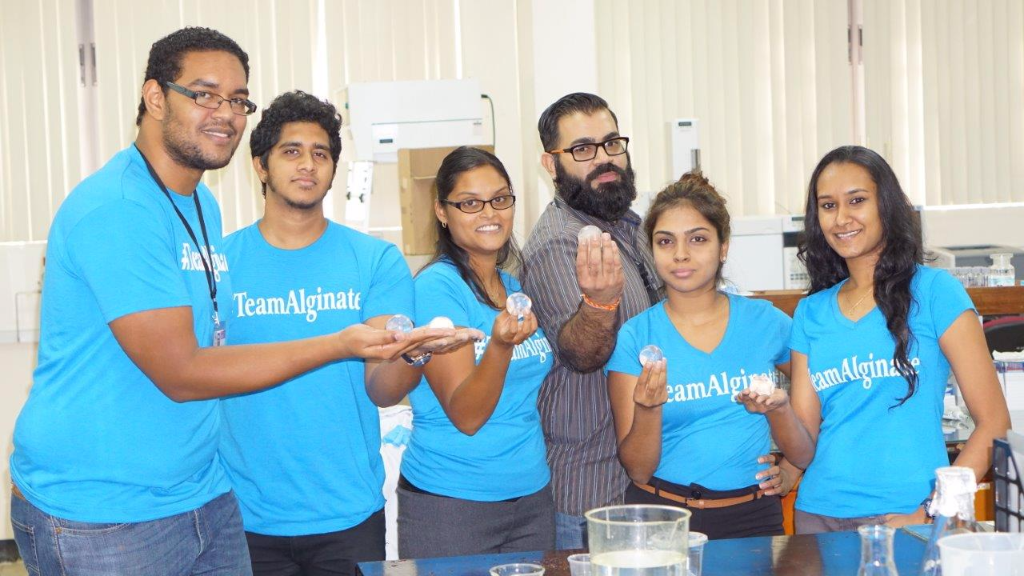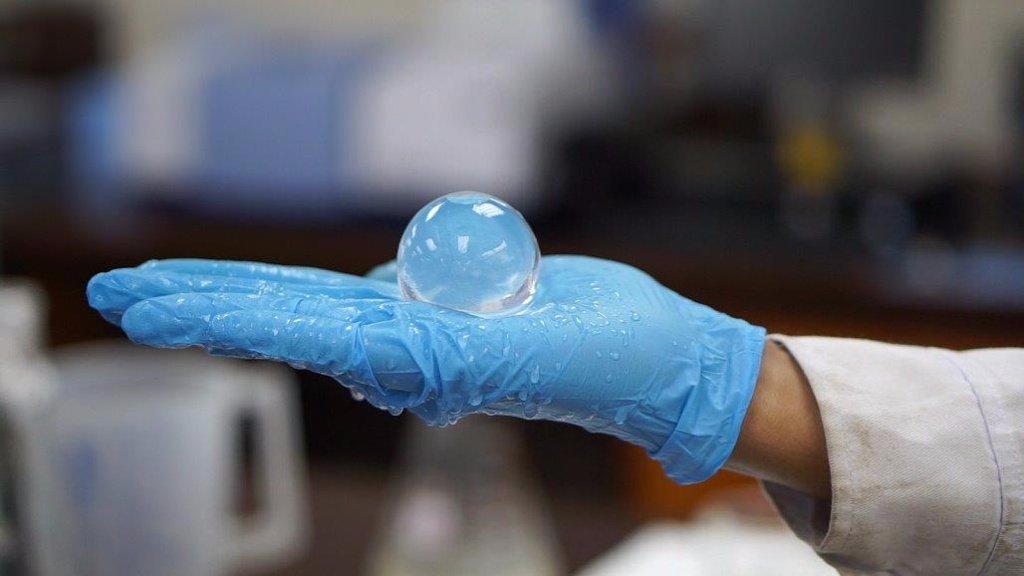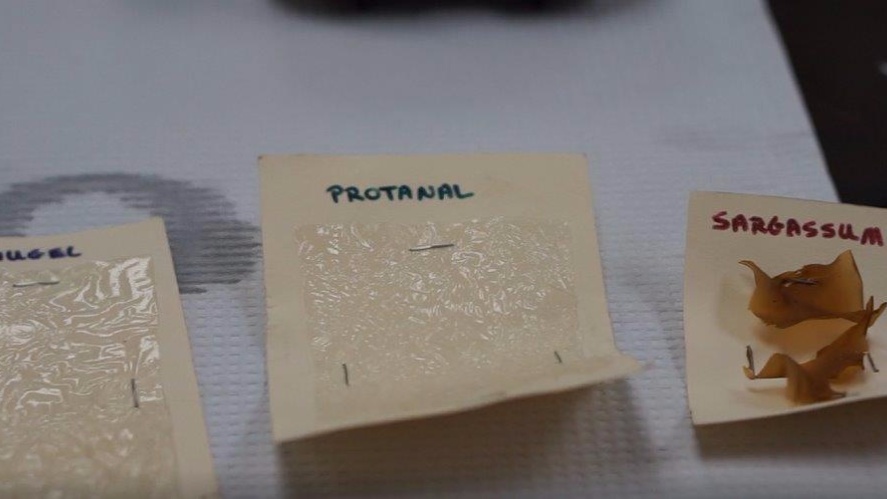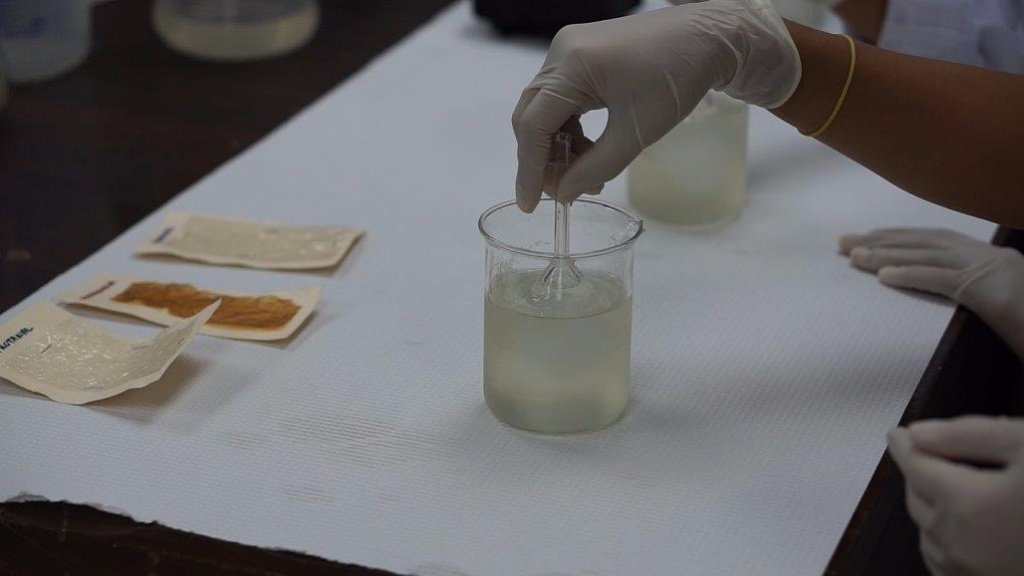UWI research team developing seaweed water bottles – UWI seaweed water bottles - Arhive
UWI seaweed water bottles UWI seaweed water bottles UWI seaweed water bottles UWI seaweed water bottles
UWI research team developing seaweed water bottles
 (Photo L-R: Dr Keeran Ward with his team at the Department of Chemical Engineering at the University of the West Indies).
(Photo L-R: Dr Keeran Ward with his team at the Department of Chemical Engineering at the University of the West Indies).
Would you buy, and drink from, a water bottle made of seaweed?
A group of students at the University of the West Indies (UWI), St Augustine, is working to develop a ground-breaking product that does just that, and more.
The team, which comprises post-graduate and doctorate students at the UWI’s Chemical Engineering department, has succeeded in re-creating the famous Ooho water bottles, and is looking to develop the technology further for use in the Caribbean region.
Team leader Dr Keeran Ward said he was introduced to the product about a year and a half ago while pursuing his PhD at the Imperial College in London, where he was invited to help work on the ground-breaking new technology.
Ward said the product has far-reaching implications for the environment as the product will be using Sargassum seaweed which has been deposited in tonnes on the country’s beaches in years past.

(Photo: Sargassum alginate has been made into edible Ooho water bottles)
“SkippingRocksLab (UK) approached me about using alginate (the element in seaweed that gives its jelly-like consistency). It’s their work. And we came on board to try to optimise their Ooho membrane.”
He said the problem lies in configuring the consistency of the membrane for distribution.
“The problem with the membrane is that it ‘sweats’ a lot, so they needed to come up with a better prototype to find out how they can encapsulate other things besides water, for example fruit juice, wine, to try to make it a bit more marketable and to encourage people to not use plastic,” he said.
The team has been researching the Thin-Film Composite Alginate Membranes for two purposes.
The first product would be plastic packaging comprised of entirely organic components which would ideally be used for conventional water bottles, replacing the traditional plastic.
These bottles, unlike typical water bottles, would decompose back into the ecosystem, reducing the problem of inorganic waste.
Dr Ward, a lecturer in Chemical Engineering, Membranes and Biopolymers at UWI, said considering the country’s recurring problem with Sargassum seaweed which accumulates every year, the product seemed like an excellent way to make use of this organic material.
“We found that there’s a lot of seaweed from the Sargassum influx which we have between April and May, and we can utilise the polymer seaweed and try to make these membranes.”
He said the team found however that the Ooho prototype is weak as a plastic.
“It’s very weak as a plastic prototype. It’s very innovative and cool, everyone likes to play with it, but if we were to actually make a bottle we’d have to come up with our own optimized prototype,” he said.
The team has since been testing the composition of the membrane in order to scale the formula up to create a plastic prototype.
The seaweed would be blended with other starches to create a more rigid structure, which could hold water, juice, wine or any other liquid.
Dr Ward says at present the membrane is able to encapsulate water for several days after it is compacted.
And, as the membrane is biocompatible (derived from a naturally occurring resource), and biodegradable, it’s more sustainable and emits fewer greenhouse gases than conventional plastics.
The team has also submitted an application to the Green Fund for assistance with their research.
Filtering out toxic heavy metals…with seaweed?
The second product being developed can have far-reaching potential for industrial development, regionally and internationally, once completed.
Many citizens are concerned about the leaching of toxic chemicals into drinking water. One example would be the Guanapo Landfill, which lies uncomfortably close to the Guanapo River, a major water source, although the Water and Sewerage Authority has assured citizens that the water is safe to drink.

(Photo: Sargassum has been proven to remove toxic lead and other heavy metals from water, which can be used for wastewater treatment.)
The use of thin film composite Calcium Alginate Membrane, if developed successfully, can be used to filter out harmful toxins from industrial and waste facilities, which might leach into groundwater and rivers after rainfall.
Dr Ward says Sargassum has effectively been proven to filter out lead and is being tested for cadmium at the moment.
Dr Ward says although they are still in the early stages, the research has tremendous implications for marketing a viable product for export.
“The aim of it is in about four to five years, is all goes well, we’ll be able to have a start-up initiative here at UWI, which is one of the goals that the new principal, Professor Copeland, has identified.”
“Our aim is to have a prototype that can be used for various products such as wastewater treatment or plastic remediation, and then we can get investors on board,” he said.
Challenges
However, it was not all smooth sailing, as the team had several hurdles, and may likely have several more before succeeding with their products.
“The alginate is good but it’s not the purest, that’s a challenge as we need to try to make it a bit more pure so that it can make a better membrane.”
“Right now the membrane is working for the wastewater treatment of heavy metal ions. These membranes eat lead, they literally take it out of the solution immediately, at least that’s what we’re seeing from the results, and with the alginate from the seaweed that we have at Manzanilla, it’s also working quite well,” he said.
The other stage, he said, is trying to mimic the properties of plastic using alginate.
“That’s a problem we’re having, but these are things that my research group is working hard on as part of their PhDs,” he said.

(Photo: Alginate being converted to form the finished membrane.)
Moving forward – a greener, safer future?
Dr Ward said the team will continue to work with the Department of Aeronautics and Chemistry at Imperial College to create an optimized Ooho prototype, as well as developing alginate extracted from local sources of Sargassum for the use of filtration membranes.
The team will also look at the effect of membrane additives such as biomaterials (starch, cellulose, pectin, clays etc.) to achieve maximum adsorption of heavy metal ions.
This will also provide a prototype sustainable bioplastic model that is able to produce less CO2 emissions and reduced environmental impact whilst also maintaining all the properties of conventional plastic.
Dr Ward also wants to assure the public that the UWI is definitely strengthening its research and development for creating technology with viable, profitable applications.
“I just want people to know that there is research going on at UWI and it’s heading in a positive direction, and we’re going to continue to develop areas of innovative research and development.”
“People who can contribute or help develop this technology are welcome to come and be a part of it,” he said.
Dr Ward added that his team is also concerned about conservation and helping to create environmentally-friendly products that can benefit the country.
“I think these products can definitely help. By making a biodegradable alternative we can try to combat the pollution, while also trying to correct the behaviour, and I think that’s where this project fits,” he said.
The research team is as follows:
Research Team
Dr. Keeran Ward (Lecturer in Chemical Engineering, Membranes and Biopolymers)
Meera Bissram (Engineering Lab Technician Chemical Engineering – Analytical Chemistry)
Bissoon Parasram ((Engineering Lab Technician Chemical Engineering – Analytical Chemistry)
Shivanie Mahabir [MSc Student Chemical Engineering- Membrane Science]
Akeem Mohammed (MPhil. Student Chemical Engineering- Plastics and Material Science)
Chantal Mohammed (MPhil. Student Chemical Engineering- Membrane Science)
Undergraduate Student Contributors
Kristy Mohammed (BSc Chemical Engineering)
Riad Beharry (BSc Chemical Engineering)
Vicard Gibbings (BSc Chemical Engineering)
Rakesh Bissoon (BSc Chemical Engineering)
Elisheba Bajnath (BSc Chemical Engineering)
UWI seaweed water bottles UWI seaweed water bottles UWI seaweed water bottles UWI seaweed water bottles
UWI seaweed water bottles UWI seaweed water bottles UWI seaweed water bottles UWI seaweed water bottles
UWI seaweed water bottles UWI seaweed water bottles UWI seaweed water bottles UWI seaweed water bottles
UWI seaweed water bottles UWI seaweed water bottles UWI seaweed water bottles UWI seaweed water bottles
